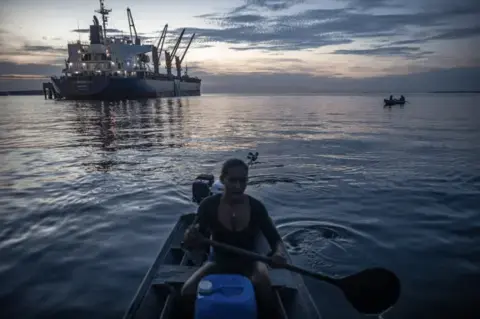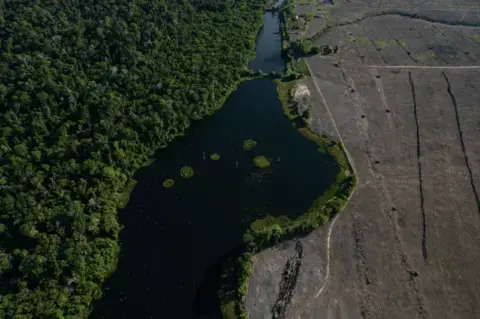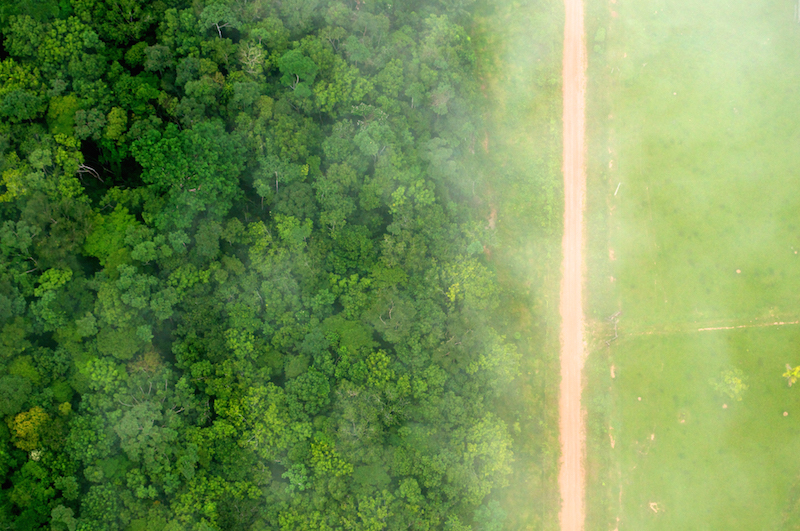The project Hungry for Meat? began in 2021, when Maria Mast, a staff journalist at Die Zeit, read that Germany was the biggest producer of meat in the European Union. This intrigued her to dig deeper into available data and trace the whole supply chain of soy: from Brazil to Germany.
“Maria Mast’s reporting emphasizes the interconnected nature of planetary health. Through collaboration, data analysis, and photography, she reports on how the production of a mundane yet vital ingredient like soy becomes entangled with the cattle industry’s role in deforestation of the Brazilian Amazon. The grantee shows us the moving stages of soy farming and how its large-scale production creates precarious living conditions for Indigenous Brazilian communities at the expense of luxurious red meat and dairy product consumption,” said Kymberley Chu, the Rainforest Journalism Fund intern.
Rainforest Journalism Fund Assistant Fernanda Buffa spoke with Mast about the project. During the interview, Mast reflected on navigating reportage beyond one’s cultural homeland.
Click here to watch the video: https://youtu.be/9DRoaHsikF4
This interview has been edited for length and clarity.
Fernanda Buffa: How did you and your team at Die Zeit obtain the information?
Maria Mast: There were a lot of documents and websites to check all of the information, we compared what the supermarkets were promising versus what they would actually do in Germany.
FB: What were the challenges in understanding/ retracing the soy supply chain across different countries/ continents
MM: We had to deal with data that is actually available. You want to know how much soy reaches Germany and how much is coming from areas that have been cleared illegally. But, to link the very bottom of the story with data, I think that was the biggest challenge. Another challenge was that many people involved in the supply chain didn’t really want to talk to journalists. For example, soy farmers who have a political position close to Brazilian President Jair Bolsonaro. It was not easy to gain access to the people I wanted to talk with. Finally, the last challenge was the coronavirus. In a pandemic, it was still much harder to calculate when to travel and where to travel. In the beginning, it was a challenge. When I was actually in Brazil, it was late autumn, and everybody in the Indigenous communities were already vaccinated. But that was difficult to determine beforehand. I wasn’t sure. Before organizing the whole trip, we wondered whether it was actually responsible to travel to all the parts I wanted to travel to.

FB: What were the main tools you used in your investigation?
MM: We used a lot of satellite data to analyze the question of how much forest was actually lost and how much soy was planted. For that, we used Planet Lab at Planet Lab Satellite. Also, we had some data that was provided by the University of Maryland about planted soy areas in the last few years. We also had data from the platform, Global Forest Watch. We used this platform to calculate some of the forest loss around the Munduruku area, the same area I traveled to in Brazil. For the land ownership system, we used the platform CAR, which is the platform from the Brazilian Ministry of Environment. We just downloaded the official data to check who registered there and how much land is actually registered, what overlaps, what is registered on top of each other, and who registered what on protected areas. These were the main tools for the data analysis.
FB: What are the tips you have to share with other journalists?
MM: The team aspect is the most important aspect. I think a good team with different skills is key to such a story. As I said, I had a very good stringer in Brazil, which helped me with appointment organization when people were not so willing to make appointments with me. I had an amazing photographer and data support. I had two colleagues from Die Zeit, Claudia Valentine and Flavio Gotanda, who helped me with all of the data I mentioned before. Another tip would be having local contacts, hanging out with them, basically. Be patient. Sometimes, appointments did not take place and I had to reschedule. As a German person, I was a bit impatient in that aspect. Just be patient and be there. Stay relaxed. I would say that to me when I started the project because I was not always relaxed. For example, I remember there was one day when all of my appointments were canceled and it was also starting to rain. Everybody else was super relaxed and said to me, “You know when it’s raining in the Amazon, everybody just stays wherever they are at this moment.” I was the only one saying, “No! We have to make an appointment.” But, everybody said no, and it was a wise decision.

Kymberley Chu: What meaningful actions can readers take? Would reduced consumption of beef and dairy products lead to challenging the cattle industry’s role in deforestation?
MM: If a German reader would want to really change something, they would reduce their beef consumption as well as soy, or finding chicken that was fed by soy grown in Europe, which is really hard. But if you would try to do it, if you would just grow your own chicken, you could actually feed it without soy. Well, there's no improbability. I think an easier way is also to just be conscious of the choices you make, and maybe even mention that to your local supermarket. Ask the supermarket. Ask them if you can guarantee for me that this product is actually deforestation-free sourced. At the very end of the supply chain, the supermarkets are the ones providing the products, and if you communicate as the consumer to them, then they realize, okay, we have to change something. Then, they will go back to the supply chain and communicate with their local meat suppliers. The meat supplier will communicate with meat delivery companies, the farmers, and so on. I think communication should not be underestimated.
FB: Did you encounter any surprises along your investigation?
MM: I don't know if it was a surprise, but it was a kind of painful process to learn how difficult it is to change an existing system. So even if you would try to certify soil in a in a sustainable way, it would be incredibly difficult because the amount of soy not only leaving for Europe, but also leaving for other countries is so huge. So to implement a system that is actually, for example, certifying a relevant quantity is so, so difficult. And then the certification process, itself, has so many challenges, like how often you visit far away farms and those, easily reachable and ready to check.
FB: What impact do you hope your story will have?
We already can report a small impact: The day after confronting the German supermarket, Aldi, with the research, they published an international position paper in which the company pledges to eliminate deforestation in its supply chains with high priority by the end of 2030. They did not have a public statement like this before, so I was quite happy to hear that.





